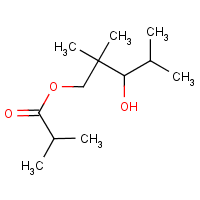Texanol
Agent Name
Texanol
CAS Number
25265-77-4
Formula
C12-H24-O3
Major Category
Other Classes

Synonyms
1,3-Pentanediol, 2,2,4-trimethyl-, monoisobutyrate; 2,2,4-Trimethyl-1,3-pentanediol monoisobutyrate; 2,2,4-Trimethylpentane-1,3-diol monoisobutyrate; CS 12; Chissocizer CS 12; Isobutyraldehyde Tishchenko trimer; Propanoic acid, methyl-, monoester with 2,2,4-trimethyl-1,3-pentanediol; Isobutyric acid, ester with 2,2,4-trimethyl-1,3-pentanediol (7CI); Isobutyric acid, monoester with 2,2,4-trimethylpentane-1,3-diol; Propanoic acid, 2-methyl-, monoester with 2,2,4-trimethyl-1,3-pentanediol; Propionic acid, 2-methyl-, monoester with 2,2,4-trimethyl-1,3-pentanediol; [ChemIDplus] 1-Isobutyrate; [CHRIS] TPM; Texanol Ester Alcohol; NX 795; UCAR Filmer IBT; [TCEQ]
Category
Other Organic Compounds
Description
Colorless liquid with a mild odor; [CHRIS]
Sources/Uses
Permitted for use as an inert ingredient in non-food pesticide products; [EPA] Mainly used as a coalescing agent in industrial paints and coatings; Used in the chemical, paints, lacquers, and varnishes, and polymers industries; Used as a process regulator, solvent, and coalescing agent; [IUCLID] Also used for architectural and industrial maintenance, as a chemical intermediate, in electrodeposition primers and coatings, floor polishes, high-bake enamels, lithographic and letterpress oil-based inks, as recovery solvent in drilling muds and ore flotation, and as solvent for wood preservatives, cosmetics, and personal care products; [ExPub: TCEQ]
Comments
A minor skin irritant in guinea pigs and minor eye irritant in rabbits; Not sensitizing to guinea pig skin; Increased absolute and relative liver weights with minor histopathological changes (considered adaptive and reversible) observed in sub-chronic oral study of rats; No evidence of reproductive toxicity, developmental toxicity, or teratogenicity in rats; [IUCLID] A skin and eye irritant; [ICSC] A mild eye, nose, and throat irritant; May cause smarting and reddening of the skin if spilled on clothes and not removed; High vapor concentrations may cause mild smarting of the eyes and respiratory system; [CHRIS] May cause irritation; [Sigma-Aldrich MSDS]
Biomedical References
Exposure Assessment
Vapor Pressure
0.0097 mm Hg
Odor Threshold Low
0.065 ppm
Lethal Concentration
LC (rat) > 3,500 mg/m3/6hr
Explanatory Notes
Odor threshold is 50% odor detection; [ExPub: TCEQ]
NFPA
must be preheated
Diseases, Processes, and Activities Linked to This Agent
Processes
Industrial Processes with risk of exposure: